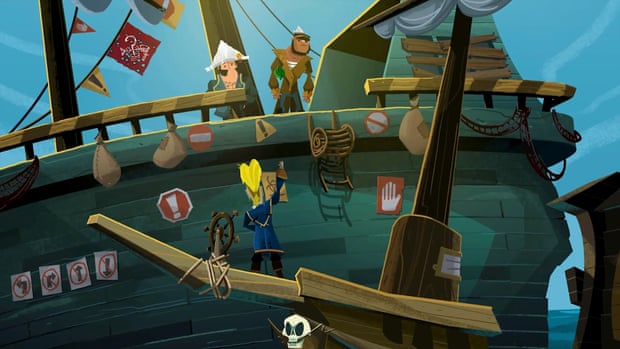Far out on the high seas, under the scorching Caribbean sun, a soft-hearted and lovably useless pirate named Guybrush Threepwood has to face a difficult question. Now middle-aged and with a grey-stubbled face, does this non-hero still have an adventure in him, or is his story said and done? It’s a question his creators Ron Gilbert and Dave Grossman, doyens of 90s comedy puzzle games who have also aged by a few decades, also have to face.
Luckily for us and them, the answer is a grog-croaked but resounding, “Aye Aye!” Return to Monkey Island is a deep belly-laugh of nostalgia that works its voodoo charm to bring point and click adventures into the 21st century. It ingeniously brings an old made-for-desktop-computers point-and-click system to the modern-day Nintendo Switch with nifty, easy-to-use controls.
In Star Wars levels of chronological complexity, this game is technically only the third Monkey Island game, despite the fact that it is the sixth to bear that name. Series originators Gilbert and Grossman made the first two but then left to work on other projects, and so have only just returned to the franchise. Needless to say, purist fans have been bubbling over with excitement. But Gilbert and Grossman haven’t written off everything that happened to the series since they left – Murray, a grumpy demonic talking skull from Monkey Island 3, makes a return. And the excellent Dominic Armato, the voice of Guybrush, is also back.
Threepwood is on the hunt for the elusive secret of Monkey Island once again, but so is his black-bearded zombie nemesis, Captain LeChuck, who leads a ghostly crew of the undead. All our favourite characters return: Stan, an annoying marketing executive who spews out nonsense jargon; Wally, an eternally young-looking cartographer who is fated to always suffer; and of course, Threepwood’s true love, Elaine Marley, a former governor turned anti-scurvy activist. The story throws us back on to Mêlée Island, but under circumstances that have significantly changed, with younger, much hipper pirates (a clear Gen Z metaphor) on the scene.
While the game has abandoned the large pixels of the 90s for eerier puppet-style art, it has kept its hilarious dialogue, bizarro storylines (in which zombies write poems as a hobby), and its relentless breaking of the fourth wall – as when characters comment on items they haven’t seen since Monkey Island 1. Critical to the whole reminiscence package is the iconic steel-drum backing music. As is traditional, the puzzles make no real sense (“this all seems needlessly complicated,” Threepwood says at one point), but involve just enough bizarro logic that it’s rewarding to figure them out. The only downside is a juvenile opening section, which works as a tedious tutorial.
The result of the old team getting together again is a tale that retreads old paths but also clearly wants to be more than just an ode to a bygone era of video games. When Threepwood goes to an oracle, Voodoo Lady, for advice, she summarises the paradox this game faces: “You must walk the path, yet you have already walked the path.” Return to Monkey Island pulls off the trick of looking backwards and forwards at the same time, reminding us that the point-and-click adventure will never really die: it’s a zombie pirate that won’t stay in the ground for long.

